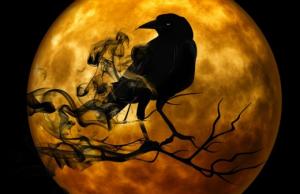
Fairies of the Baltic Lands
Baltic fairy is known as lauma (singular) (plural laumas). Worship of these creatures in Baltic lands dates back to Mesolithic times and belief in them is even older than the Baltic pantheon with different gods and goddesses. Laumas were servants of Laima the Baltic goddess of faith. Laumas were also closely connected to the Baltic earth goddess Zemyna. Worship of mother earth is ancient and dates back over 30 000 years within Europe. Both Zemyna and Laima were some of the most worshipped and respected goddesses in Latvia and Lithuania during Pre-Christian times.

Half Women Half Animals
Laumes were nature spirits connected to different elements. The first image of laumas was not very pleasant. Laumas were described to be metamorphic. They were hybrids between human women and animals. They had the upper body of a woman, bird claws and the middle torso of a horse, bear, goat or dog. Many times they had only one eye in the middle of the forehead. Some of the laumas were similar to centaurs in Greek mythology. Laumas were believed to be seducers who were extremely dangerous, especially to men. Laumas had a dual role in society. They were protectors of women, children and orphans. Laima the goddess of the faith was highly worshipped especially among pregnant women because she was the one who was in charge of the child´s faith. These early stories about the laumas come all the way from Mesolithic times. Dating all the way back to the time after the ice age when groups of people moved to new living areas. Maybe these early stories of Laumas were inspired by the totemic beliefs of these early people.
Guardians Of Nature
During thousands of years, the image of laumas changed and became closer to the idea of how we in the modern world see fairies. They were no longer hybrid creatures but instead, they looked like ordinary women. They were slim ladies dressed in silk. Laumas were not described to have wings but it was possible that some of them did have wings. According to some legends, Laumas were spirits of passed-away orphans. Laumas were guardians of nature and connected to different elements. Air, fire, water and earth. They lived in forests, lakes, abandoned bathhouses, swamps and meadows. These fairies loved to sing and dance. After the dance, when they walked away, their footprints would turn into mushroom rings and flowers. Laumas had the power to invite rain and create thunderstorms. This is probably influenced by Slavic mythology where Rusalki the water spirits had similar powers.

Laima Goddess Of Faith
Laumas were connected to weaving and spinning. The spinning wheel was the symbol of Laima the goddess of faith and destiny. The thread that she was spinning was the symbol of human life. Laima was in charge of everything that happened in the lives of humans but also what happened in nature. She was told to be a talented weaver who weaved all human lives together. Laima was highly worshipped among humans because she was the one who was in charge of everyone´s final destiny.
Vaiva and the story of the Rainbow
There is a beautiful story from Lithuania about a fairy called Vaiva. Perkunas the thunder god was in love with Vaiva but she was in love with a mortal man. A musician called Straublus. Perkunas took Vaiva into the skies and forced her to live there with him. Vaiva had a colourful belt that she threw from the skies to earth to Straublus. This belt was the rainbow. There are other versions of the story and according to one Vaiva was getting married to Perkunas but the moon goddess Menulis was in love with her.

Fairy Godmother
In Lithuania, laumas were connected to the woodlands and to the fertility of the land but in Latvia, they were connected to motherhood and the magic of birth. In Latvia, it was believed that if the mother died during childbirth, lauma would become the fairy godmother and the protector of the child. It was lauma´s duty to protect the child during their entire life. In Middle, Ages Europe was a constant battlefield between different countries, cultures and religions. Goddesses like Laima were demonized and she was turned into an old hag. This was also the time when Baltic society became more patriarchal and warmongering. The ancient pagan belief systems in Baltic lands had been matriarchal and goddess-oriented without bashing male deities. All fairies were demonized together with the goddesses. When before Lauma was someone who guarded the child and was the protector of orphans, now Lauma became an evil character who killed the child or purposely killed the mother so that they could keep the child to them-self. The faith that Laima faced was a faith she shared with several other goddesses around the world.
Legacy of laumas still lives in Baltic lands where you can find several ancient pagan shrines. They are under protection and part of the cultural heritage.
















